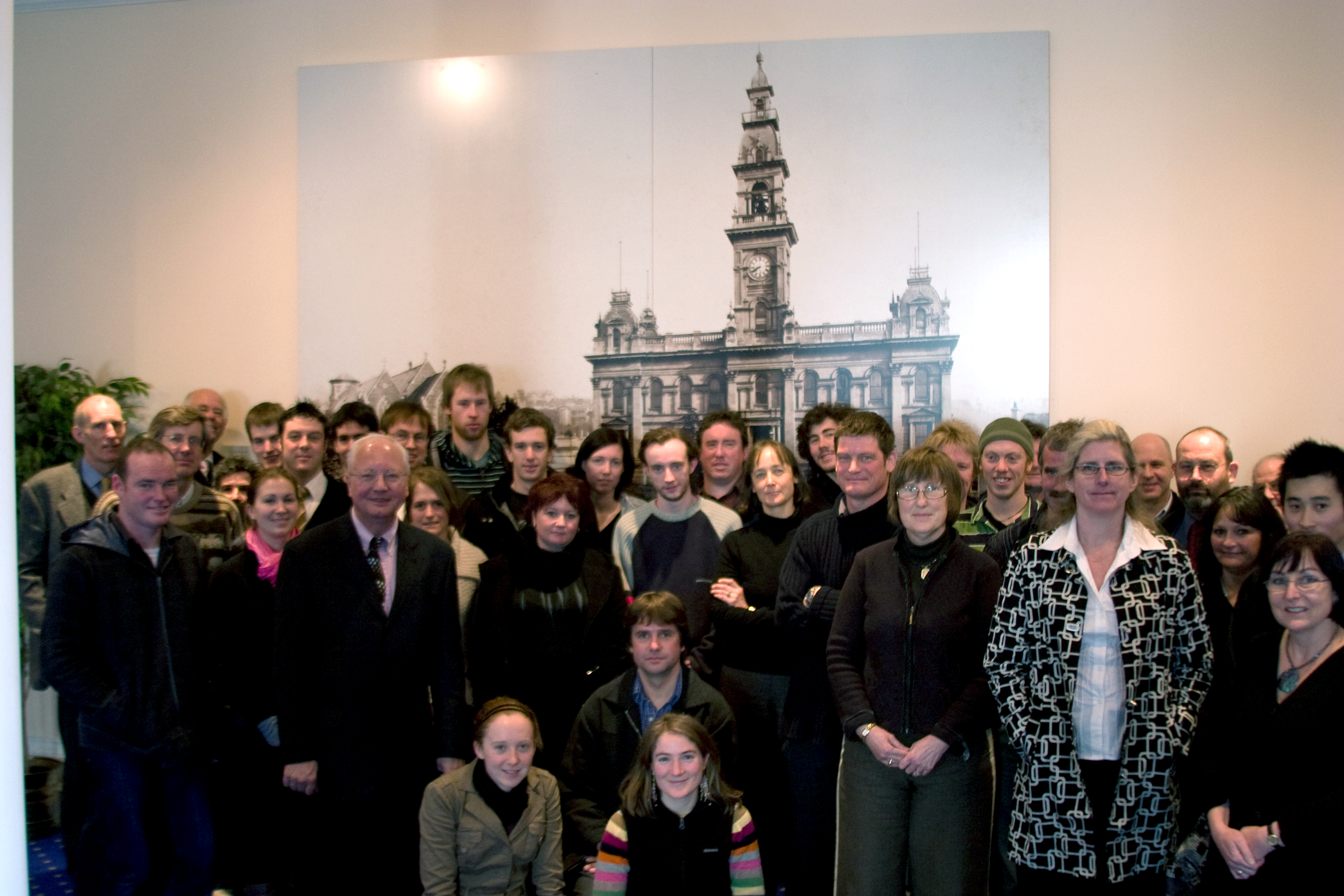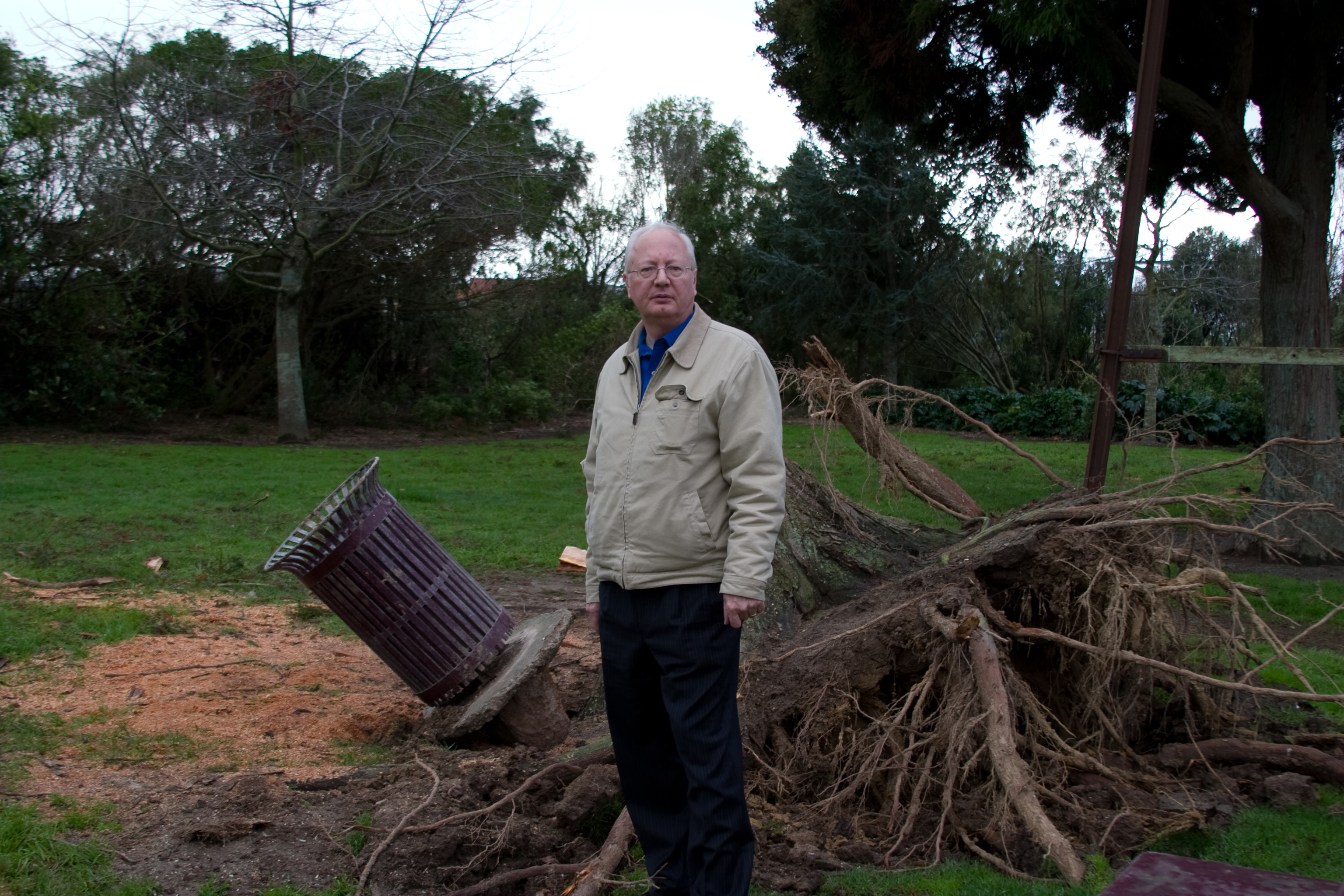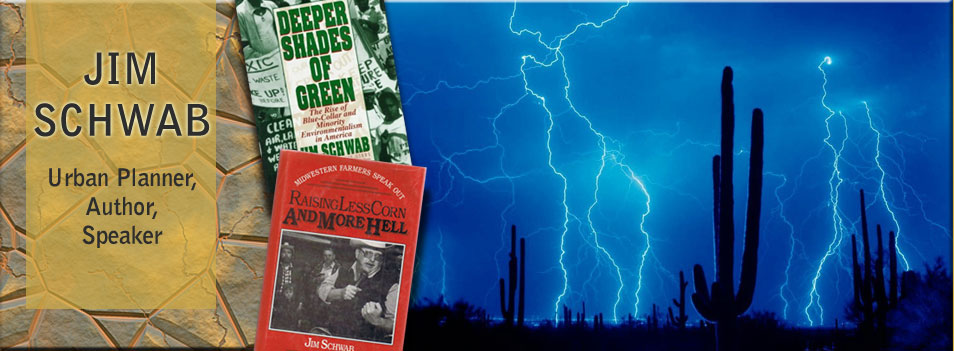Photo Essay: New Zealand
New Zealand
(All photos by Jim Schwab unless otherwise noted.)
Occasionally in life, there are times when one wants to say, “I can’t believe I’m getting paid to do this.” I enjoy my work, I often love my work, but seldom would I say that doing it felt like a vacation. My three weeks in New Zealand in 2008 induced that feeling, however—which is not to say that I did no work while there. In that period, I delivered seven lectures and seminars, sometimes feverishly revising PowerPoint files between appearances, traveled in and out of five national airports, and prepared a white paper for my hosts, the Centre for Advanced Engineering in New Zealand (CAENZ), at the University of Canterbury in Christchurch.
In that period, I delivered seven lectures and seminars, sometimes feverishly revising PowerPoint files between appearances, traveled in and out of five national airports, and prepared a white paper for my hosts, the Centre for Advanced Engineering in New Zealand (CAENZ), at the University of Canterbury in Christchurch.
Left: Jim Schwab with crowd after two-hour seminar in Dunedin for students and faculty at Otago University)
| It’s just that New Zealand is such an intriguing, beautiful place to be, and the people are remarkably civilized and pleasant. In the photos and comments that follow, I hope that I convey those positive impressions while recognizing that New Zealand, like any other |
||
| Below: Jim poses with “Frodo” at Stansborough, a Seaview, Wellington, firm that manufactured all the costumes for Lord of the Rings and raises its own sheep to produce a unique brand of wool. | Kristin Hoskin, Jim’s fellow traveler for much of the New Zealand tour, experiences the “snow” that greeted the children in Chronicles of Narnia as they moved through the magic wardrobe into the even more magical world of Narnia. The set is part of the Stansborough factory tour. | |
The invitation to come to New Zealand arrived, via Kristin Hoskin on behalf of CAENZ, in the winter of 2008 and eventually jelled into a trip from July 25-August 15. I gave up a Chicago summer for a New Zealand winter. One of the consistent questions that emerged among American friends was why New Zealand was so interested in spending money to attract an American expert on planning for natural hazards. My simple answer was a question: “Have you seen Lord of the Rings?” If the answer was yes, I replied, “The movie was filmed entirely in New Zealand. Think about the landscape.” As if to reinforce what I was saying, the winter weather upon my arrival the last week in July turned increasingly sullen, wet, and miserable, though some days were quite pleasant. But storms were moving into the North Island from the ocean and making clear, in some cases, that New Zealand was a nation of noteworthy natural hazards. This was of only minor consequence the first few days. After my arrival on a Sunday morning, we spent several days in Wellington attending the Australasian Natural Hazards Management Conference at Te Papa, the national museum of New Zealand. I spoke there about lessons learned from the 1993 Midwest floods, an assignment I had expected before realizing that history would be repeated to some degree in the devastating 2008 floods that struck Iowa and some neighboring states. I added shots I had taken in late June in Cedar Rapids and Iowa City to my presentation. Clearly, recent events had made my presentation at the conference considerably more timely. |
Below: New Zealanders have been adept at finding lucrative niches in the Hollywood movie industry. Weta Studio’s small museum in Wellington was the home for this sculpture of Golub, the lost soul of Lord of the Rings, which was produced by another New Zealander, Peter Jackson. Weta is heavily engaged in animation projects for a wide variety of movies. | |
Below: Our guide, a retired cellist from the Wellington Symphony Orchestra and expatriate American from Downers Grove, Illinois, begins a Landrover tour of Lord of the Rings film sites for a mixed group of us including Americans, Australians, one Brazilian, and one German. We had one thing in common: We were all fans of the movie trilogy. The tour began in Queenstown, a resort village in the Southern Alps, surrounded by some of the most gorgeous natural scenery on the planet. |
||
| Below, left: View of the wet, chilly weather in Wellington from an upper floor of Te Papa, the national museum. | Below: Jim meets over lunch in Te Papa with Wendy Saunders and Julia Becker, both with GNS Science, a crown research facility in New Zealand whose focus includes issues like landslides (landslips in NZ terminology) and other geologically related development issues. | |
| As the weekend approached, however, the issue of the storms loomed larger. CAENZ personnel had arranged for a helicopter tour over Mount Ruapehu, an active volcano on the North Island, on Saturday, but it had to be scrubbed. A laconic veteran pilot who was to take us, when asked that morning about the weather, said only, “Doesn’t look good.” The interpretation, I was told, was that he had no intention |
||
| Jim stands in front of tree damage in a small town after serious winter storms sweep the North Island. |  |
|
Below: Displays in the visitor center at Tongariro National Park relating to volcanic hazards of Mount Ruapehu.
Despite the obvious disappointments connected with the scrubbed helicopter flight, the storms that swept the North Island were in reality but a minor display of the potential disasters awaiting New Zealand if nature were to unleash its full fury.
One major concern that links New Zealand with California, to which it bears some similarity in size and in its long north-south orientation, is its seismicity. New Zealand, of course, has a
far smaller population and is an island nation, but earthquake faults run the length of the land, crossing from the waters west of the South Island to those east of the North Island, and traversing Wellington, the capital, which lies at the southern end of the North Island on a peninsula buffeted by strong winds across a narrow strait. (The airport, as a result, does not exactly afford an airline pilot’s dream landing.) One presentation at the conference in Wellington concerned a December 21, 2007, earthquake in Gisborne, a small city on the eastern shore of the North Island, the result of offshore tremors. New Zealand engineers have been spurred by circumstance to invent effective new systems for protecting major buildings. Base isolation systems that separate buildings from earthquake shocks lie beneath both Te Papa and the New Zealand Parliament, the long building behind another government building affectionately known as the Beehive because of its design.
The significance of landscape-related hazards is so great that it is reflected in an institution that is in some respects an equivalent of the U.S. National Flood Insurance Program. New Zealand’s Earthquake Commission (EQC), using a surcharge on property insurance, insures against geologic hazards including both landslides and earthquakes. In the U.S., curiously, landslides are one disaster that remains completely uninsured, largely because the risk pool would be so self-selective as to guarantee losses for any insurer who ventured into that market. On the other hand, the U.S. ventured into effectively nationalizing flood insurance for much the same reason, but the losses nationwide were far greater. The Earthquake Commission serves additional purposes, such as public education and research on seismic hazards.
The issue of landslides particularly interested me. Although landslides do occur naturally, in modern society they are more often the product of unwise development practices. We disrupt the delicate balance between friction and gravity that holds hillsides in place by building roads and homes and farming. There are technical solutions to the problems we create, but there are also times when we might best say that developing a particular area involves too much risk and that retaining it in open space may be the wiser option.
In the New Zealand case, the issue is quite stark. It is estimated that as much as 95% of the landscape was “bush” prior to human settlement. This term basically refers to a dense temperate rainforest. Some of that bush was thinned following the arrival of the Maori, Polynesian settlers, in the 1200s. The process was intensified with European settlement beginning in the 19th century. Much of the land was converted to grasslands for sheep farming. Sheep outnumber humans about ten to one in New Zealand, a land that was home to few mammals (such as seals and sea lions) larger than rodents before humans arrived. The Maori brought pigs; the British brought sheep, who now number nearly 40 million. One result, however, has been steady erosion of hillside farmlands, which must be remedied over time by reforestation, where possible, and improved farming practices, to stabilize the soil. Without such remedies, eroded soil clogs rivers, which increase flooding in downstream communities.
Below: Pedestrian entrance to the native bush exhibit outside the Te Papa building in Wellington. The intent is to show how most of New Zealand appeared before human settlement began. Humans are a relatively recent “introduced species” on islands of recent geologic origin, but well removed from any continental land base. Australia is at least 1,200 miles away.
Encounters between the British and Maori in the 19th Century often involved hostilities. This redoubt was used by Maori warriors, the inventors of trench warfare, to fend off British troops struggling to conquer the interior by marching through the dense bush surrounding such forts. The Maori today remain a visible part of New Zealand life and politics, and Maori is a
second official language with English. Like North American experiences with American Indians, the journey toward co-existence has not always been easy, but greater mutual understanding is imperative.
Planners for the North Island’s Horizons region, centered around Palmerston North, the home of Massey University, took me into these farming regions to show not only the problem but to discuss some of the incentives and programs they were using to encourage farmers to adopt better practices. They are making progress, but encountering some resistance, and achieving sustainability will be a long, slow process. One planner expressed a concern that consumers elsewhere in the world may discover that farming in New Zealand is “not as wholesome or green as they thought it was.” That may be true, but others have a long way to go, too. And it is possible for New Zealand farmers to reclaim that mantle, as have many farmers elsewhere.
Below: Planners and other professionals at the Horizons regional office, including host Greg Carlyon, in Palmerston North, who met and worked with Jim over two days discussing development issues. Another very interesting individual I met was Professor Bruce Glavovich, of Massey University, where I conducted a seminar on post-disaster recovery planning.
Below: New Zealand goes renewable: Wind turbines dot part of the rural landscape outside Palmerston North.
|
Above, right: Stopbanks, the NZ term for what Americans call levees, seek to prevent flooding of farmlands adjacent to a river. |
|
|
Below: Hilltop entrance to the cable car between the Wellington Botanic Gardens and Lambton Quay. |
|
Below: Near the cable car is the hilltop entrance to the city’s gorgeous botanical garden, whose walkways traverse the hills. |
|
Below: A view of the Wellington skyline from the hilltop where the cable car ends. |
|
| Below, left: Children’s play area at the botanical garden. | Below, right: Environment House houses the national Ministry for the Environment, where I spoke to a joint meeting of both Ministries for the Environment and Civil Defence/Emergency Management about planning issues related to national hazards policy. |
Queenstown was a very different place, much more resembling a ski town in Colorado than the predominantly coastal larger cities of New Zealand. Below: Squeezed between mountain and lake, upscale development nonetheless springs up in Queenstown to accommodate increasing demand for the good life. |
|
Above: The “piano man” plays aboard the T.S.S. Earnslaw, a steamer that has plied Lake Wakatipu since 1912 and affords an outstanding tourist opportunity to view the mountains from the water. But beware: In winter, the cold wind and water can provide a bracing experience. |
Above: A view of snow-capped mountains from the T.S.S. Earnslaw. |
|
|
Above: Walter Peak Station, a popular tourist stop along Lake Wakatipu. |
|
This bungee jumping station (pictured right), we were told, decided a few years ago to boost business by offering free jumps to anyone willing to jump naked. Revenues declined as large numbers of jumpers simply doffed clothing to gain a free jump. Those of us on a Lord of the Rings film site tour who learned this bit of news joked among us that this qualified as a classic case of “failing to understand one’s clientele.” |
|
It was not tourists or developers who were first drawn to these mountains, but in many cases miners seeking their fortunes amid daunting hardships. New Zealand had its own gold rush soon after California’s, and miners poured in from numerous places, including China, populating mining camps and small mountain villages. However, the remnants of those settlements often are tourist attractions now, reminding us all just how hard life was in these hills just a few generations ago.
Left: The entrance to an old gold mine. People were a bit smaller than me in those days, but this still must have produced some sense of claustrophobia.
Below: A small Chinese miner’s home, with script intact above the entrance. |
|
In New Zealand, cities and nature can live side by side, though as in any other country, strong public support of conservation efforts are required to ensure success. One excellent example is the nature preserve on the Otago Peninsula in Dunedin, on the southern end of the eastern shore of the South Island. Dunedin took its name from its predominantly Scottish settlers, but is now one of New Zealand’s largest cities and home to Otago University. The nature preserve allows limited numbers of visitors on guided walking tours that are well worth the price to see wildlife including sea lions, seals, albatross, and penguins. Above: A viewing center with blinds allows a reasonably unobtrusive view of wildlife, particularly, in our case, a baby albatross on a hill below. |
|
|
|
Sea lions nestle among the rocks along the Pacific shoreline. |
Penguins march up a trail toward our tour troupe, something our guide told us some biologists had insisted they would not do (see penguin video). |
|
Our tour group follows a prescribed trail away from the shore. |
Penguins march uphill en masse in what seemed an endless procession out of the sea (see video #1131). |
|
|
This, to me, represents a high representation of civilized achievement: the ability to live peacefully together in cities while also finding ways to live peacefully with the other species that
inhabit the planet with us. No place is perfect in this respect, but in the Otago Peninsula, New Zealand seems to have come a long, long way toward the ideal. Jim Schwab |
The city of Dunedin nestles in the hills in the background, a hilly city along the Pacific coast. |
